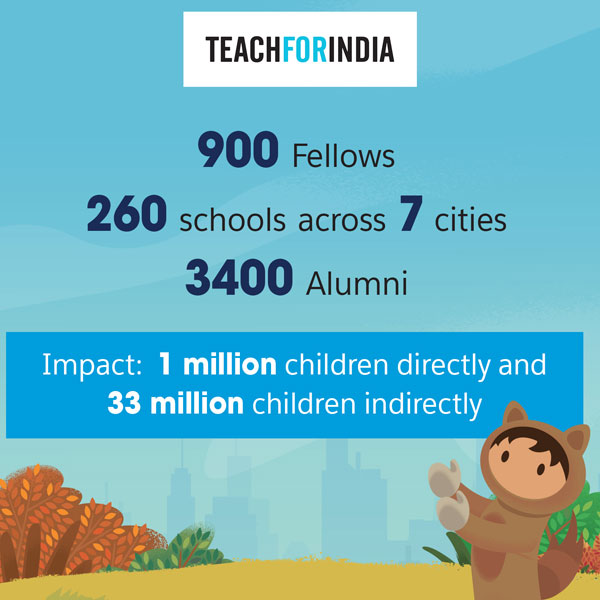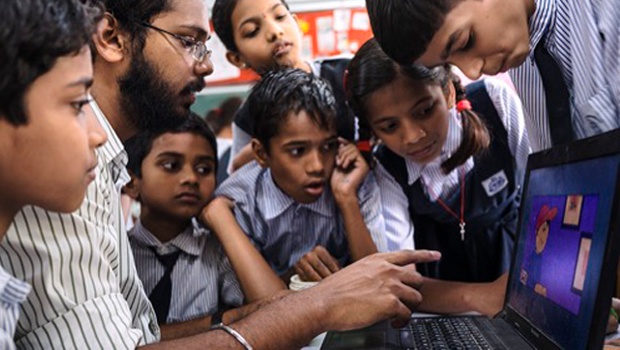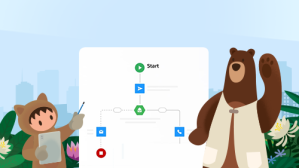Building Educational Equity in India – The Teach For India Story



Teach for India has made education a reality for 33 million children. To continue the good work, TFI uses technology to streamline crucial processes and to successfully tackle challenges thrown up during the pandemic.

Salesforce India
32 million children in India, up to 13 years of age, have never attended any school. Teach For India was born in 2009 from a desire to bring equity in education, and to help every underprivileged child in India unlock their true potential.In the last 10+ years, through all its endeavours, this nonprofit organisation has directly impacted one million children, and indirectly reached 33 million children across the country.
What started as 87 Fellows is today a nationwide movement of 900 Fellows and 3400 Alumni who strive to bring quality education and equal opportunity to every child in India.

The Teach For India model
Some of the brightest young minds from India’s best universities and workplaces join the Teach For India movement as a Fellow. These Fellows serve as full time teachers for two years across 260 under-resourced schools in seven cities, impacting the lives of 32,000 children from underprivileged backgrounds.
The two years spent teaching and working in close association with key education stakeholders is an opportunity for Fellows to comprehend the grassroots reality of India’s education system. At the end of the two years, the Fellows acquire the knowledge, skills, and mindset to take up leadership positions in and beyond education.

“Teach For India Alums work at various levels of the system. They are involved in educational policy-making, serve as teachers and school leaders,launch their own initiatives and organisations, and work to spread awareness about the movement,” says Sara Khan, Director of Development, Teach for India.
Teach For India’s model employs a strict recruitment and selection process, teacher training, and leadership development programme. The impact on the students themselves and the leadership growth of Fellows are measured regularly. And finally, considerable importance is given to the impact the Alumni have on the education system as a whole.
Using technology to meet goals
For most nonprofit organisations, getting exposure for their cause and raising funds is a key concern.Teach For India leverages the power of technology to further its cause, build connections, and make an exponential impact.
Back in 2009, Teach For India used Excel sheets to record and track applicant data. As the number of applicants grew rapidly, this system proved inadequate. Three years later, in 2012, Teach For India adopted Salesforce for its data management and has never looked back since.
Here’s a snapshot of how technology is an indispensable part of Teach For India’s operations and processes:
Fundraising: For tracking its fundraising goals, identifying new leads, managing the donor lifecycle,and managing expenses, the Development team at Teach For India employs data reporting tools and customisations built on the Salesforce platform.
Recruitment & selection: In the last 7 years, the organisation has received around 15000 applications every year for the Fellowship. And a lean 10-member selection team has seamlessly scaled up its operations with a suite of automations.To guide teams in identifying high-potential candidates, Teach For India has integrated tailored algorithms into its recruitment and selection platform built exclusively on Salesforce.
15,000 annual applications for Fellowship positions managed by a 10-member team
Impact & engagement: Crucial data points related to impact and engagement for each Fellow are captured in real-time. Regular engagement surveys are conducted, and all the data is consolidated on Salesforce – easily accessible to all through dashboards. This facilitateseffective and efficient decision making around the future course of action with regards to classroom teaching, leadership skill development, transformational projects in community, etc.

Platform extensibility: The in-house technology team can continually automate and enhance processes on the highly extensible Salesforce platform. These automations have helped to save 500+ hours in a year, with teams using the reporting and analytics tools for insights into the data. These insights have also improved the accuracy and fairness of processes.
Coping with the pandemic challenge
When the pandemic hit the world, Teach For India was quick to change course and took upon itself to arrange for food, ration, and financial assistance for its children and their families. Fellows also kept close tabs on the mental and emotional well-being of their students.
To ensure that the children did not miss out on their lessons while the schools remained shut, the organisation focused its efforts on starting online lessons. Through corporate partnerships, Teach For India managed to deliver tablets to 1600 students, which they plan to increase to 10,000 over the next few months. These tablets have been secured with strict student access control and come loaded with a play store that has dedicated applications for student learning.
The six-week-long residential training of Fellows (given before a Fellow takes over classroom teaching) was moved online as well.
A completely online mode for both training and teaching is a first in the history of Teach For India. But the organisation was able to deal with this unprecedented switch with great agility, given its long-standing exposure to technology.
“We already had access to video conferencing tools, which our Staff had been using for meetings and discussions, and also for certain training for Fellows,” explains Hitesh Rawtani, Technology Director, Teach for India. “This helped in terms of being aware of what technology solutions can be used. So, it was just a matter of extending those solutions to all Fellows and students.”
Going forward, the organisation plans to scale the role of technology in classroom-teaching, with blended learning gradually becoming the new norm.




















